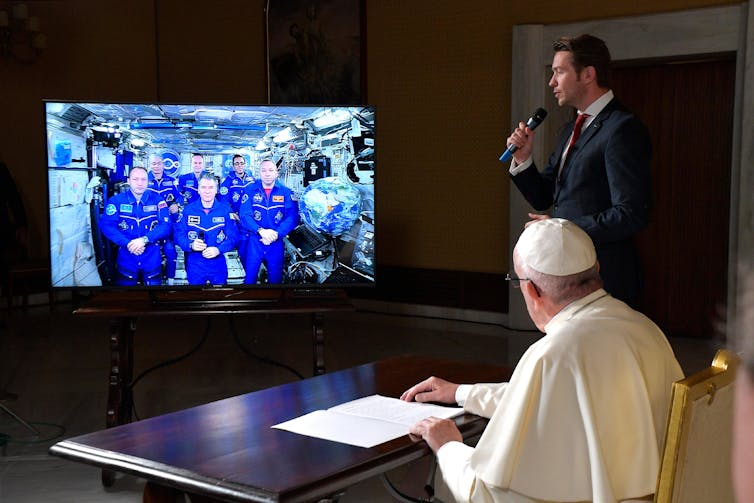
AP Photo/Gregorio Borgia
Heidi A. Campbell, Texas A&M University
The year 2025 is a Year of Jubilee: an event held every quarter-century that calls Catholics around the world to embark on a holy journey of faith and repentance.
For some, that journey is a literal pilgrimage; for others, it is an opportunity to embrace humility and nurture hope. The yearlong celebration is filled with events and activities centered on seeking forgiveness.
In early January, Catholic news outlets released a reminder that Catholics are eligible for special indulgences this year. Indulgences are pardons believed to eliminate earthly suffering or time in purgatory – where the Catholic Church teaches that people who have confessed their sins are purified before entering heaven.
Among the traditional religious activities that can earn one an indulgence – such as pilgrimage to holy sites, acts of charity and saying special prayers – Pope Francis introduced a new option: a call to fast from the internet and social media. His official decree suggests individuals abstain “in a spirit of penance, at least for one day of the week from futile distractions (real but also virtual distractions, for example, the use of the media and/or social networks).”
As a scholar who studies how religious groups use and respond to new technologies, I find it notable that the pope frames the internet as a spiritual distraction. This announcement may seem like a departure from the Catholic Church’s previous approach to digital media, especially since not long ago the church embraced online tools to keep congregations connected during the COVID-19 pandemic.
This highlights an evolving and complex technological landscape Catholic leaders have had to negotiate over the past century, each time new forms of media emerge. Many clergy see technology as both a valuable resource for the church and a potential harm or interference.
Sacred ‘selfie’
The church has long embraced communication media to advance its mission. In the early 20th century, Pope Pius IX acknowledged that movies could be important tools for teaching about faith and values, even though he decried many films for their “portrayal of sin and vice.” For decades, American Bishop Fulton Sheen embraced radio and television for preaching and even won Emmy Awards for his shows.
As pope from 1978-2005, John Paul II saw the rise of the internet and was quick to see its potential for church communication. In 2002, he announced that the internet should be seen as “a new forum for proclaiming the Gospel” if used “with competence and a clear awareness of its strengths and weaknesses.”
Pope Benedict XVI, who became pontiff in 2005, encouraged the creation of a papal profile on the social media platform X, formerly Twitter. He praised social networks and apps that can enable “reflection and authentic questioning.”
When Francis’ papacy began in 2013, his succinct and candid communication style made him easily quotable, earning him a reputation for being media-savvy and publicly engaged. News reports of his “first selfie,” taken in 2013 with a group of young tourists at St. Peter’s Basilica, also earned him the nickname the “digital pope.”
This photo went viral and presented Francis as fan of social media. That impression was further promoted by his 2014 sermon on the Church’s World Communications Day, when he described the internet as a “gift of God,” enabling the church to evangelize around the world.

L’Osservatore Romano/Pool Photo via AP
Like Francis’ other early statements about technology, this sermon emphasized established Catholic teachings on social communication and media, set out after the Second Vatican council. The resulting document, Communio et Progressio, advised clergy that mass media such as TV, radio and newspapers should be seen as tools to promote unity and understanding between people.
From hearts to machines
While Francis has continued to advocate for using digital media in ministry, the tone of his statements over the past decade have grown more cautious and sometimes even critical. In fact, as I have noted in my research, he communicates a much more cautious view of digital media than the two popes before him.
In his 2023 World Social Communications Day message, for example, Francis spoke about the ways social media often promotes and exploits false images and ideas, and he emphasized the need to return to the basics of “speaking with the heart.” Francis presented direct, person-to-person communication as the ideal, while criticizing the negative interactions “we experience especially on social media.”
The following year, Francis spoke pointedly about AI, expressing strong concerns that the current generation of technology must be regulated so that it is not used to spread disinformation or distort the “wisdom of the heart.”
“Such wisdom cannot be sought from machines,” he added, but comes from communication centered on God and human compassion.

AP Photo/Gregorio Borgia
The Jubilee call to Catholics to consider technology abstinence as a mark of spiritual devotion is very much in line with the pope’s move toward becoming more vocal and critical in his views about how technology is affecting society.
To be clear, Francis does not deny that technology can offer benefits in communication and community building for the church. The Vatican has indeed described technology as a “digital door” to the Jubilee. Also in December 2024, officials launched an AI-powered “digital twin” of St. Peter’s Basilica, created through a partnership with Microsoft, for people who cannot make a pilgrimage in person.
Nevertheless, my research shows that Francis is notably more conservative in his views about digital media than can be seen in the messages and initiative of John Paul II and Benedict before him. Through his papacy, Francis has shifted focus from stressing opportunities offered by digital tools to highlighting concerns created by digital environments where many of us spend more and more of our everyday lives.
Heidi A. Campbell, Professor, Texas A&M University
This article is republished from The Conversation under a Creative Commons license. Read the original article.
































































